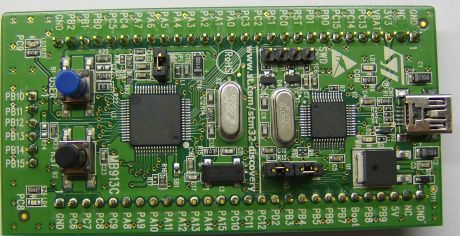en.radzio.dxp.pl
Main menu
Index
Privacy policy
Youtube channel
PCB Manufacturer
Tutorials
STM32F429I-DISCOVERY
STM32VLDISCOVERY
Code library for LCD
S1D15705
SSD1963
SED1335/RA8835
SED1520/NJU6450
SED1530/SPLC501C
KS0108/HD61202
S6B0724
T6963C
ATMEL AVR microcontrollers
HD44780 driver
1-wire driver
Delay utilities
Decoding RC5 infrared
iButton CRC computing
iButton reader
ATtiny2313 board
ATmega162 board
STMicro ST7 microcontrollers
Software I2C impementation
External I2C EEPROM memory
Projects
SPI bus sniffer
I2C bus sniffer
1-wire sniffer
AVR910 programmer
Software
Bitmap converter for LCD
Modbus Master Simulator
STM32VLDISCOVERY evaluation board
STM32 Value-line discovery board is a low-cost evaluation board for Value-line of STM32 microcontrollers from STMicroelectronics. Value line of STM32 microcontrollers are low cost version of higher devices. It's can run on 24MHz and dont have some of peripherals avaiable on higher devices. On this board is soldered 64-pin value-line STM32 (with ARM Cortex-M3 core) microcontroller and ST-Link debugger, so board is complede hardware needed to run programs for STM32 devices! You olny need USB cable for connection board to PC.

Of course, we need build some external hardware because on the STM32LVDISCOVERY are mounted only two LEDs and two pushbuttons - one for RESET and one for user application purposes. Discovery board has two long row of pinheaders and one short (between them) with all important signals from microcontroller and power supply voltages. Due to this short connector STM32VLDISCOVERY board can not be placed on typical solderless board. Base board for discovery board will be described in one of articles.
This tutorial shows you how to write applications for STM32 devices without use STM32 StdPeriph Library. This library in my opinion isn't best solution for writing apps for STM32 and I show You that writing apps without this library is easy and fun. Although this tutorial is based on STM32 Value Line micros and STM32VLDISCOVERY board in most cases can be also used for other STM32F1 (mainstream) devices and other development boards.
Articles :
Programming STM32VLDISCOVERY board with Eclipse and Sourcery Code Bench open source tools NEW
Flashing STM32VLDISCOVERY MCU memory using command line ST-Link utility and Keil uVision IDE
Tutorial :
Lesson 1 - First program. Blinking LED
Lesson 2 - Reading the Button
Lesson 3 - Blinking LED with timer
Lesson 4 - Blinking LED with timer interrupts
Lesson 5 - Blinking LED with timer hardware
Lesson 6 - Pulse width modulation (PWM)
Lesson 7 - Analog to Digital Converter (ADC)
Lesson 8 - Simple communication with USART
Lesson 9 - ADC with Direct Memory Access